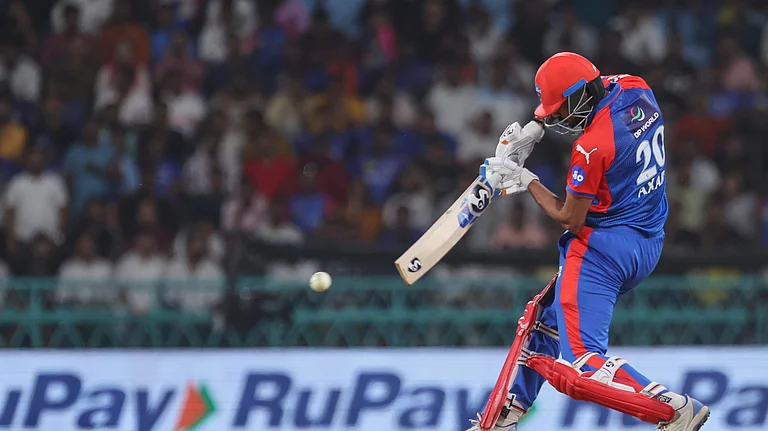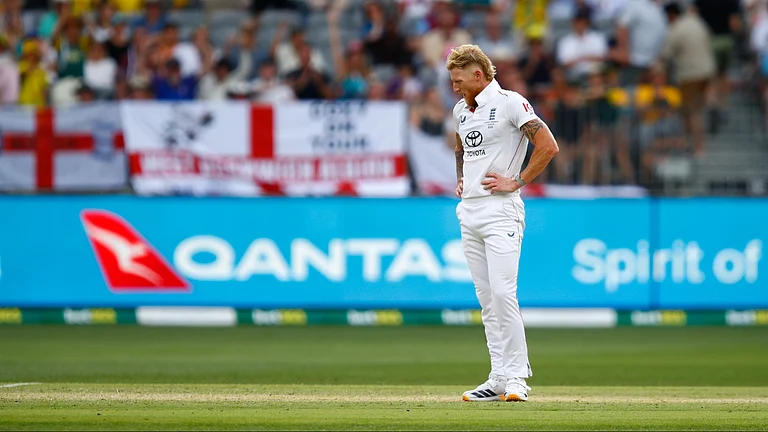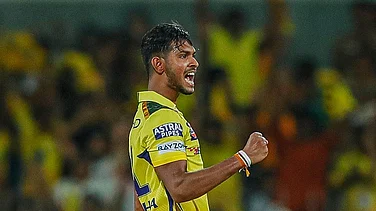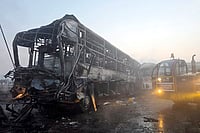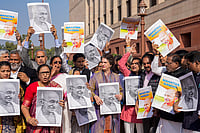THE two-week all-expenses-paid holiday to the United States of America is all over for the 47-strong Indian contingent. True to the great tradition of rejecting all that glitters, the tyagis return—having spurned gold, silver and even bronze to the best of their abilities. And up there, somewhere, in the centenary year of his creation of global sport's most spectacular smorgasbord, Baron Pierre de Coubertin must be applauding the bunch of no-hopers from a land of 950 million—probably 951 million by now—who fulfil his ideal of 'taking part, not triumphing', in letter, spirit and deed, Olympics after dreadful Olympics.
When had we last chased lucre? Sixteen years ago in Moscow, in hockey, and that because no one else wanted to. Had liberalisation sown the seeds of 'conspicuous consumption'? It hadn't. And in the custom-made clothes designed by Ritu Beri, the Indians looked thoroughly exposed. Where had we a chance? Look at it through that other great Indian tradition—superstition. We contested in 13 events and, well, 13 is 13 is 13. Maybe we should have contested 12 or 14 events, or perhaps not at all. Oh, no. "Obviously not everybody is going to win, but that doesn't mean we should stop participating," says V.K. Malhotra, senior vice-president of the Indian Olympic Association (IOA).
Oh, hell, we tried. "Jaspal Rana crashes out". "Devendra Thapa bows out". "Chandrashekhar fails". "Chetan Baboor loses, Radhika out". "Dipankar out". "Judokas no match". "Boxers get tough draw". "Indian challenge ends". "Hockey hopes recede." "Paes only hope". There is something surreal about those headlines. If you hadn't seen them before in Barcelona 1992, Seoul 1988, Los Angeles 1984, and in a hundred international meets before, where were you?
An overreaction? Look at the great expectations that had been whipped up—by the media, by the athletes, by the coaches, by the officials, and by those new Gods of Indian sport, the sponsors—and you will know how India has been laid low. Barring tennis tykes Leander Paes and Mahesh Bhupathi, and the young badminton player P.V.V. Lakshmi, there wasn't even a whimper.
Says three-time Olympian Mervyn Fernandes: "Except for hockey, and Milkha Singh and P.T. Usha, who came close, we've never won. One can blame the Government and the system, but that still doesn't answer why we have not produced an Olympic or world champion. How much more can the Government do? Maybe, the player also has to develop an urge to win."
IS there the urge to win? Take shooter Jaspal Rana. The 21-year-old shot a poor 534 out of 600 in the 50-metre free pistol event to finish last in a field of 45. And shot 574 (below his own personal best) in the air pistol final to be placed 29th. "I should've done better. But I didn't practice much," he said. Come again?
Take wrestler Pappu Yadav. Overweight even before he left for Atlanta, Yadav couldn't be squeezed into the 48 kg category because he was missing. He was desperately trying to shed weight in the sauna. Entered into the 52 kg category as a last-ditch attempt, he was thrashed 10-0 in the Greco-Roman category.
Take equestrian Inderjeet Singh Lamba. The Government refused to clear the Services rider. But the IOA and the Equestrian Federation joined hands to get him, his mount 'Karishma', and the groom and coach G.M. Khan to Atlanta at a staggering cost of Rs 30 lakh. They left 10 days before the opening ceremony and were yet to begin training two days before the Games began. Lamba finished last in dressage in the 35-rider field and was eliminated in the endurance test.
Take the athletes. Again refused clearance by the Government, two of them, Jyotirmoyee Sikdar and Shiny Wilson, refused to run in the individual events, and were slated to take part only in the relays. Elsewhere, Milkha Singh may be telling the BBC that the best policy is to catch 'em young. But the return and reign of P.T. Usha, 32, and Shiny Wilson, 31, says it all.
Take judoka Aarti Kohli, beaten out of sight in the first round in 3:30 secs, and in the repechage bout in 2:49 secs. Take boxer Devendra Thapa, thrashed so badly, the referee had to call off the contest. Take swimmer Sebastian Xavier who finished 49th overall from 63 starters.
Take table tennis player Ambika Radhika who lost in the opening round in 14 minutes. Take boxer Lakha Singh. Take shooter Mansher Singh. Take swimmer Sangeeta Puri. Take the weightlifers. The list is endless, the story is the same.
"Why should the participants be sorry? It is the officials who have to be sorry for the current state of affairs," asserts athlete Adil Sumariwalla, who competed in the 100m event at the 1980 Moscow Olympics. Adds Eddie Sequeira, who participated in the 5,000m event at the 1972 Munich games: "Unless the Government places top athletes to head the advisory board, there will be no improvement. The selectors in the federations are more politicians than sportsmen. The only reason more sportspersons are sent is that then more officials can go abroad. What's the point in sending a 4x400m relay team of this vintage? If they were younger, at least they could have been groomed," he says.
Ignore the poor show, ignore the medals tally—it was only to be expected. Beyond that, Atlanta 1996 was an 'official' disaster.
For the 47 sportspersons who went to peddle their shallow wares, there were at least twice as many officials—managers, coaches, doctors, observers et al—freeloading on the trip of a lifetime. Three species were on view. The Government delegation accompanying Sports Minister Dhanushkodi Adityan, officials of the IOA, and the 'observers' from different states—comprising state ministers, MPs and their lackeys. Wrote V. Krishnaswamy of The Indian Express : "It's difficult to give a precise number on how many officials are here, but a good estimate would be 70-80." The 10-member Government delegation comprised two former sportspersons, one retired athlete and officials of the Sports Authority of India (SAI), one of whom is believed to have made 10 trips in the past three years. Each official cost the Government $200-$300 per day. Before emplaning for Atlanta, IOA officials, hurt at lack of government clearance for its chosen ones, alleged the Government was spending more on the delegation than on the athletes. But the boot is also on the other foot. The entire IOA official-dom is in Atlanta, cheering the boys (and girls). Just how many, IOA will not say.
How so many 'officials' managed to accompany the Indian contingent is a mystery quite easily explained by the fact that the IOA's four-yearly elections are due in November this year. One official, who claimed he had 11 votes in his kitty, was among those who sought (and got) clearance to go to Coke Town. The Government delegation left in two batches on the plea that not all could secure accommodation at the same time. The ruse helped split expenditure estimates and obtain Government approval. But what did the second delegation plan to do when the Indian show was over? Most stayed out of reach of the 38 accredited Indian pressmen covering the disaster. The crash of TWA Flight 800 on the eve of the games came in handy. The Games Village, where they are housed, has become a fortress. A host of them have usually been out—shopping and sightseeing.
That most of the officials were on freebies, sponsored or otherwise, was obvious from the fact that no official reservation of seats at the events had been made for them ( see 'Jaunty Roads' ). At the venues of the hockey matches, severe wangling for tickets and passes was the order of the day. Wrote the Express '
Krishnaswamy: "Sponsorships or no sponsorships, some things never change." One official went out of Atlanta to see his relatives before his wards' events. Another arrived in the United States, but stayed put in New York.
Despite their heavy presence, the officials made little difference to the athletes' plight. The Government-cleared athletes were stuck at New York's John F. Kennedy Airport for seven hours without a connecting flight.
NOR could the officials ensure that the team members got their usual $25 allowance. Although IOA had managed to mop up sizeable sponsorships through deals with AT&T,Citibank, Nike, Motorola and Reebok, it was a hand-to-mouth existence for the athletes in a city where a half-bottle of water costs 99 cents.
AT&T had promised $1,000 per person but that sum was reportedly disbursed in Indian currency back home because the transnational would have got ensnared trying to secure RBI clearance for the largesse which even Indian companies had considered worthless to heap on the desi contingent.
Not everything Indian was awful in Atlanta. There were successes—but off the playing field. Ashwini Kumar, contesting for a four-year term on the ruling executive board of the IOC, lost by a mere two votes to Dick Pound, the committee's savvy marketing chief tipped to succeed IOC's long-time czar Juan Antonio Samaranch. And there was Adars Anand—the cricketer-turned-businessman from Meerut. Anand's Nelco brand of sports equipment is in great demand with the IOC. "Our products are being used here, and that's like winning the gold medal."
Finland, with a population of 5.08 million, has won 289 medals in modern Olympics—which is a medal for every 17,632 Fins. India, with 950 million, has won 14 at the rate of one per 68 million Indians. China, with 1.2 billion people, has 114 medals—one for every 10.5 million Chinese.
Given those depressing figures, it's difficult to explain Dhanushkodi Adityan's callous optimism. Adityan proclaimed: "We hope to get 100 medals in the next Olympics." How, he did not explain. No one could ask him either. For, soon after making the statement he vanished. The buzz was he had gone to Florida to meet some relatives.
Perhaps, Parliament will like a little debate before the Indian bandwagon—teeming with officials, observers—surfaces again at Sydney in AD 2000.







